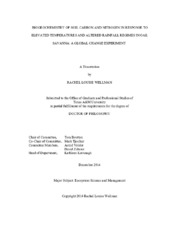| dc.description.abstract | Increasing concentrations of greenhouse gases are projected to elevate global surface air temperatures by 1.5 to 4.5 °C by the end of the century, and magnify the intensity and variability of seasonal precipitation distribution. The mid-latitude savannas of North America are predicted to experience substantial modification in precipitation regimes, with a shift towards drier summers and wetter spring and fall seasons. Despite these predictions, little is known concerning the effects of these global climate change drivers or their potential interactive effects on the carbon (C) and nitrogen (N) biogeochemical cycles. In the post oak savanna region, I examined the effects of warming and rainfall manipulation on: (1) seasonal variation in root biomass and root C and N pool sizes, (2) soil organic C (SOC) and soil total N (STN), and (3) rates of N-mineralization, nitrification, and N-losses via leaching in soil subjected to experimental warming and rainfall manipulation. Research was conducted between August 2008 and April 2010 at the Texas Warming and Rainfall Manipulation (WaRM) Site in east-central Texas. Treatments included plots comprised of Juniperus virginiana and Schizachyrium scoparium monocultures and a J. virginiana + S. scoparium combination in native soil. Warming alone and rainfall redistribution alone seldom affected the response variables in this study. Species composition and time appeared to be the most consistently important main effects; however, warming and rainfall redistribution interacted with other experimental variables to influence root biomass and soil nutrient pools. N-mineralization rates were dominated by a 3-way interaction of species x rainfall x time and a warming x species composition interaction, and SOC and STN results were dominated by rainfall x species, highlighting the complexity of global change impacts. The combined results of this study suggest that soils beneath J. virginiana and S. scoparium growing alone or together behaved as carbon sinks during years 6 and 7 of this climate change experiment. These changes in root dynamics, soil C and N, and rates of soil N-transformations in response to global change drivers may have important implications for ecosystem dynamics in the oak savanna region of North America. | en |


